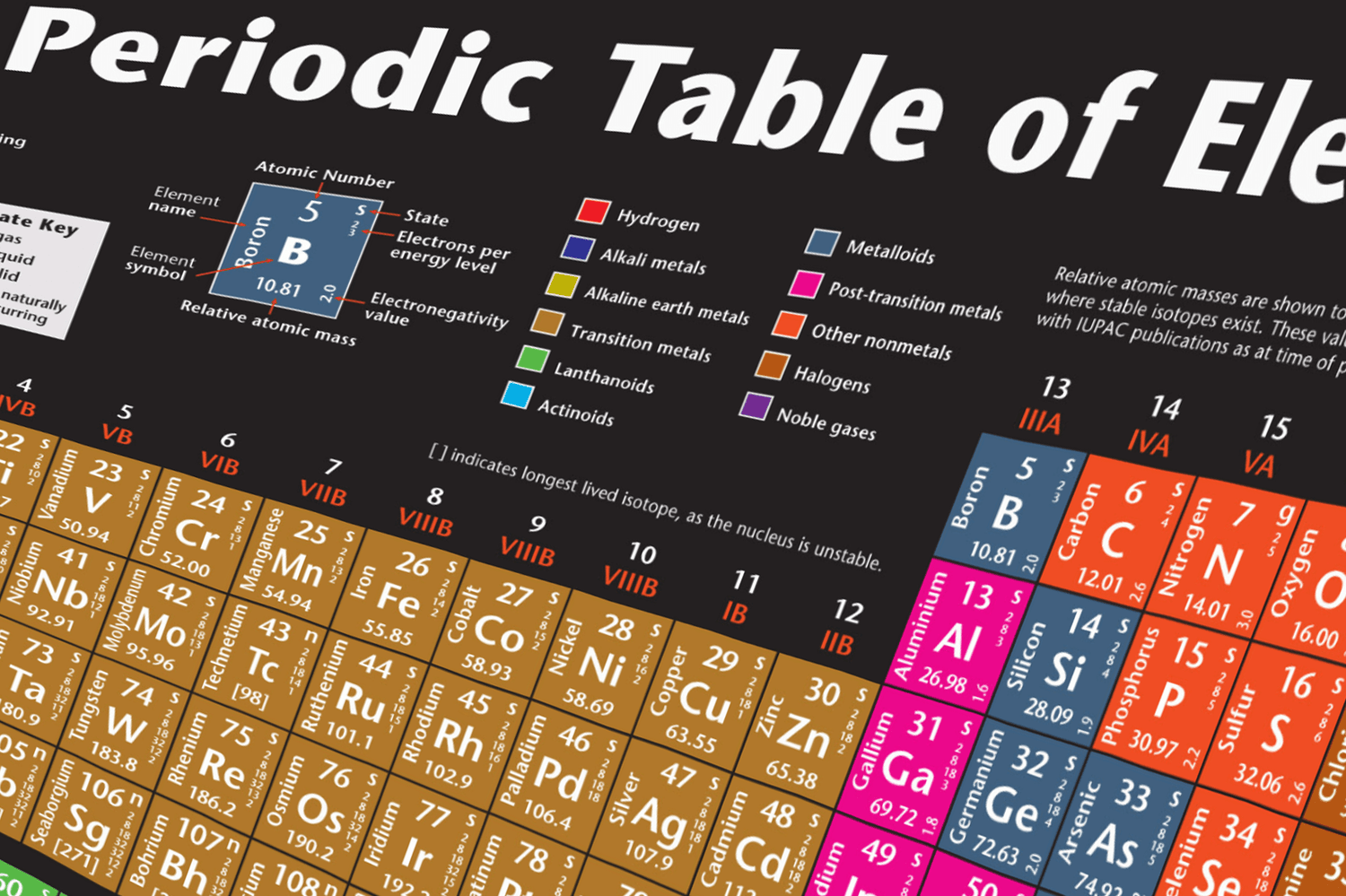As a cornerstone of chemistry and a testament to human curiosity, the periodic table is an indispensable tool for students learning the foundations of science. In this article, we will explore the myriad benefits that a high-quality, IUPAC-sourced periodic table can offer students.
A Gateway to Chemistry
The periodic table serves as a comprehensive visual representation of the elements, enabling students to explore the building blocks of matter. In its organised and systematic layout, the periodic table creates a natural curiosity in students, sparking their interest in chemistry and inspiring them to delve deeper into the subject. A well-designed periodic table is an invaluable resource, with each element's information serving as a starting point for a student's journey into the wonders of chemistry.
A Unifying Framework
The periodic table is not just a list of elements; it is a grand organisation of the elements according to their properties, atomic number, and electron configurations. It offers students a holistic understanding of the connections between elements, fostering critical thinking skills and facilitating a deeper comprehension of the subject. By displaying the recurring trends and patterns across the elements, the periodic table enables students to identify relationships and make predictions about the properties of elements and compounds, developing their problem-solving abilities.
Encouraging Memorisation and Retention
A periodic table is an essential tool for memorisation and retention of essential information about the elements. When a high-quality, IUPAC-sourced periodic table is displayed prominently in a classroom, it becomes an integral part of the learning environment. Regular exposure to the table reinforces students' knowledge of the elements, their symbols, and their properties, making it easier for them to recall this information when needed. By having the periodic table at their fingertips, students are more likely to retain and internalise crucial concepts, ultimately leading to better performance in assessments and a deeper understanding of the material.
Enhancing Interdisciplinary Learning
The periodic table is not only a vital resource for chemistry students but also a gateway to interdisciplinary learning. The elements and their interactions are at the core of many scientific disciplines, such as physics, biology, geology, and astronomy. By understanding the periodic table, students are equipped with a fundamental knowledge base that can be applied across various scientific domains. This interdisciplinary approach fosters a broader appreciation of the interconnected nature of scientific knowledge, empowering students to make connections between seemingly disparate subjects and develop a well-rounded scientific literacy.
Promoting Inclusivity and Accessibility
A high-quality periodic table can be designed with inclusivity and accessibility in mind. This can include features such as clear, large fonts for easy readability and colour-coding to highlight patterns and trends. Such features ensure that students with diverse learning needs and preferences can engage with the table and derive maximum benefit from it. By providing an accessible and inclusive learning tool, educators can foster a more equitable learning environment, enabling all students to thrive in their study of chemistry.
Cultivating Historical and Cultural Appreciation
The periodic table is not just a scientific tool; it is also a historical and cultural artifact. It represents centuries of scientific discovery, collaboration, and innovation. By studying the periodic table, students can develop an appreciation for the efforts and contributions of countless scientists who have shaped our understanding of the world.
Incorporating stories of discovery and the lives of influential chemists into classroom discussions can help students appreciate the human side of science, making it more relatable and engaging. This, in turn, can inspire students to consider their roles in shaping the future of scientific discovery and innovation, fostering a sense of responsibility and purpose in their own learning journey.
Encouraging Environmental Awareness
The periodic table offers an opportunity to discuss the role of elements in the environment and their impact on our planet. Many elements have unique environmental applications or consequences, such as the use of rare earth metals in green technology or the environmental concerns surrounding heavy metals like lead and mercury. By linking the periodic table to real-world issues, educators can encourage students to develop a sense of environmental awareness and responsibility. This understanding can help students become informed global citizens who are better equipped to make thoughtful decisions about the use and conservation of Earth’s resources.
Supporting the Development of 21st Century Skills
In today's rapidly evolving world, it is essential that students develop 21st-century skills such as critical thinking, problem-solving, communication, and collaboration. The periodic table provides an excellent platform for nurturing these skills. By engaging with the periodic table, students learn to analyse patterns, make predictions, and solve complex problems. Classroom discussions and group activities cantered around the periodic table can help students develop their communication and collaboration skills, as they learn to articulate their ideas, listen to others, and work together to solve problems.
Moreover, the periodic table serves as a foundation for digital literacy, as students often use online resources and technology tools to explore the properties and applications of elements. By interacting with digital tools, students can develop their digital literacy skills and become proficient in navigating the technology-rich landscape of modern education and the workforce.
Stimulating Creativity and Imagination
The periodic table can also serve as a springboard for creativity and imagination in the classroom. Educators can design engaging activities that encourage students to think beyond the properties of the elements and imagine new possibilities. For instance, students can create stories or artwork that incorporate elements, explore hypothetical scenarios involving element-based inventions, or investigate how the elements might behave in extreme environments such as outer space. By fostering a creative and imaginative approach to learning, the periodic table can help students develop a deeper appreciation for the beauty and wonder of the scientific world.
In conclusion, a high-quality, IUPAC-sourced periodic table is an indispensable resource in the classroom, offering numerous benefits to students. By promoting curiosity, critical thinking, interdisciplinary learning, inclusivity, historical appreciation, environmental awareness, 21st-century skills, and creativity, the periodic table is far more than a mere list of elements. It is a powerful tool that can help students unlock their potential, develop a love for learning, and become well-rounded global citizens, poised to make meaningful contributions to the world of science and beyond.


